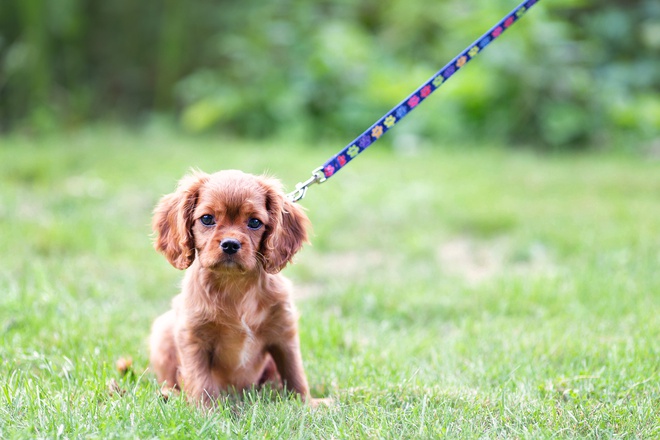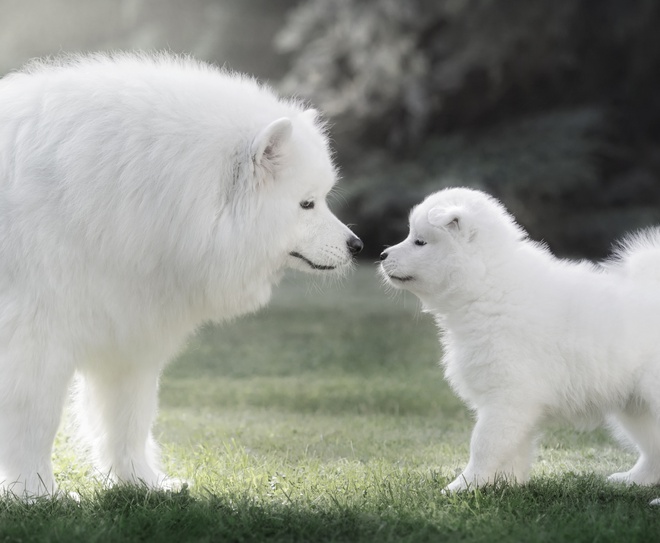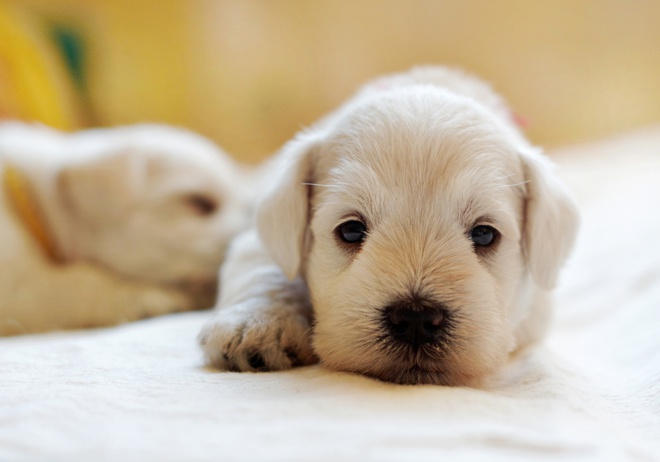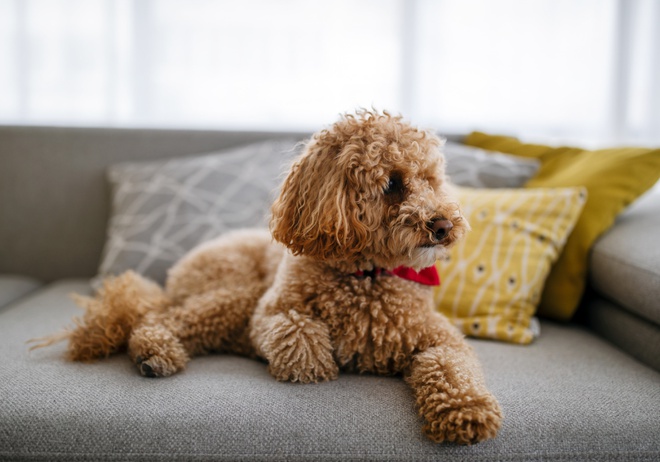How to train a puppy
Welcoming a new dog into your family is exciting, but it is essential to properly take care of them with training. A well-trained puppy will become a confident adult who respects the rules you set. Find out in this article the important steps to follow, as well as the difference between training puppies and older dogs.

Reading time : 7 min
It is always a great joy to welcome a puppy. It is an opportunity to prepare your house for their arrival, make room, buy a new bed, bowls, puppy food and other toys. It is essential for the puppy to find their bearings and to get used to their new territory. A new member whose arrival delights the whole family, but who will also require total dedication.
Although a happy decision, it is far from being insignificant. It will change your family life for at least the next 10 years. The education of a pup is therefore very important.
TOPICS
First training tips for puppies

Although dog training is intended to provide structure, teach obedience, cleanliness or not to bark, it can in no way change the dog’s nature and temperament. In other words, dog training can never turn a Jack Russell into a calm and composed dog, just as it cannot turn a Beagle into a couch potato.
It is important to consider the character of the adopted puppy, even though the basic commands remain the same. And of course, the prerequisite for a good education is successful socialisation.
Socialise the puppy
Successfully training your canine friend is only the result of good socialisation. If the puppy was separated too early from their mother, it can have an impact on the puppy’s well-being, and they can become a challenge to train.
The American Kennel Club (AKC) and the Kennel Club (UKC) both recommend that we should leave puppies with their mother until at least 8 weeks of age. During the first eight weeks of their life, a mother will teach her pups touch and affection by licking them, which is vital in their bonding process and making them feel safe.
A puppy will learn about competition for resources and attention and how to coexist with other dogs. The mother will also make sure to keep her puppies in check by telling them off and moving them. As you will not be able to get your new puppy until he is eight weeks old, a breeder will have already started this process.
Some breeders prefer keeping puppies with their mother until they are 12 weeks old, leaving time for the first two terms of vaccination. During these four weeks, puppies will develop their personalities and will also be less likely to contract any diseases.
Therefore, it is possible to adopt a puppy by 8 weeks, as they are independent of their mother and can eat solid food, but it is highly suggested to wait until the 12 weeks mark to be sure that the puppy will be fully ready to join their new home.
Teach your puppy their name
When training a puppy, you should teach one trick at a time as to not overwhelm your doggie. Training sessions should remain short, fun and happen regularly, as puppies have short attention spans. Repetition is key!
Teaching a puppy their name does not require any techniques, but you should avoid calling your puppy by other nicknames at the beginning as it could be distracting.
Say your puppy's name in a cheerful tone and when your dog turns to the sound, mark the moment, with a clicker for example. Then reward your dog with a treat or praise and affection. This method is called clicker training.
Get your puppy used to wearing a collar
The collar should be put on as soon as possible so that the puppy can get used to it. If they have trouble with it, you might prefer using a harness. A lightweight collar or harness made of fabric or woven nylon is best.
At first, the puppy will wear the collar or harness for a short period. Then, as the days go by, they will wear it longer until you never remove it. This is the first essential step in learning to walk on a lead and to wear a GPS collar for dogs. It will then be possible to walk your puppy without fear of possible runaways.
When to start training a puppy?
When adopting a puppy, the first trick you should teach is potty training, which can take up to two months. It is now recommended that puppies start training at 8 weeks of age. In other words, you can start training your puppy as soon as you adopt them, as adoption under 8 weeks is not allowed.
First tricks to teach your puppy

How to potty train a puppy?
When potty training a puppy, it is important to use positive reinforcement: you should never scold them or mete out punishment for mishaps in the house, but praise and reward your puppy when they do their business outside.
Of course, it is important to take the puppy out as often as possible to help them understand the connection between doing their business outside and receiving a reward. You should take the puppy out first thing in the morning, after every meal and before going to bed. As time goes by, the rewards will become less frequent, but house training will be acquired.
Once wearing a collar and housebreaking have been acquired, then you can start teaching your puppy to sit, lie down or stay, always with the same principle of reward, whether it be treats, petting or just praise.
How to teach your puppy recall?
How to train your puppy? Cooperative Care, known for positive reinforcement training, is the best way to train puppies and can be done during walks.
Hide-and-seek is a fun way to train a puppy to recalls. While another person holds the puppy, the owner hides behind a tree or bush not far from the puppy at first.
Then the owner will call the puppy and reward them as soon as the puppy finds him. Then repeat the process, increasing the distance by a few steps each time.
In this way, the puppy will associate the recall with a positive experience and will not be reluctant to come back as soon as the owner calls.
How to teach your puppy to drop it?
Toys are very useful when training your dog. Many puppies love to chase balls or Frisbees, so you should not hesitate to mix games with training sessions. However, they are often less inclined to give the object back.
When the puppy returns to the owner, simply crouch down and present the puppy with a treat, then exchange the treat for the object to get the puppy to let go. You should not hesitate to use words like "drop" or "give" as long as they are always the same. You should only use rewards until the puppy understands what is expected of them.
These games based on mutual happiness reinforce the complicity in the relationship between an owner and his dog. Good communication with the puppy enhances the bonding and trust that is established.
In addition, these training games are a pretext for prolonging walks without them being perceived as boring for the owner.
You should frequently change your walking routes to refine the puppy's already well-developed sense of smell. It is also important to differentiate between potty training walks and longer walks to release your dog’s build up energy.
How to teach your puppy to sit?
With your dog in an upright position, hold a treat near his nose. Keeping the treat near their nose, raise your hand up a little and over their head, towards their back. As the dog lifts their head to follow the treat, their rear end will rest on the ground.
As soon as they sit down, praise them and give them the treat. Repeat this several times in short but regular sessions. You can then add the key word "sit". Be careful not to say it before your dog gets into position.
Now that your dog has learned how to sit on cue, begin to phase out the treat rewards, but continue the praise. Only reward the faster sits with a treat, while still praising the slowest sit. This way, your dog should sit as soon as you tell them to.
10 questions to test your pet training knowledge
Do you know everything there is to know about training dogs and cats? Answer our 10 questions to find out!
Best ways to train a puppy

Don't change your habits
It can be tempting when you get a dog or puppy to take a few days off work to look after them and be around more. It is, however, not necessarily a good idea. It is important not to change your habits. The puppy will quickly understand that they will have to be left alone during certain times of the day.
They will have to learn how to occupy themselves, how to restrain themselves from doing their business, etc. To help the puppy not feel lonely, the owner can place an old piece of clothing with their scent in the puppy's basket.
They can also provide dog toys or even make a simulation game for the puppy that involves retrieving treats. This is a fun way for the puppy to kill time without feeling the loneliness of their owner's absence.
Teach your puppy not to pull on the leash and not to chase small animals
Another important trick to teach your puppy is to stop leash pulling and stop your dog from running after small animals. Although it can be fun to let a puppy chase a cat on a walk without catching them, the running animal is naturally identified by the dog as a target.
Allowing the puppy to chase small animals, even in an innocuous way, reinforces their predatory instincts. As the dog grows older, they will identify a running animal or even a child as a target and this behaviour may be difficult or impossible to correct. Leash training your puppy is therefore essential.
Don’t raise your voice
Finally, the puppy is particularly sensitive to tone of voice, so you should try to not raise your voice and always encourage them to adopt the right behaviour. Similarly, violence is not indicated in puppy training, otherwise the puppy will close in on themselves and, worse, adopt a behaviour opposite to the one desired.
The difference between training a dog vs training a puppy

Once the puppy has become an adult, some dog owners may decide to continue training their dog. A relationship and bond have already been established between the owner and the dog, thus making communication easier between the two.
Adult dogs also have a higher concentration capacity than puppies, meaning that you will be able to train with them for longer. Generally, adult dogs remain playful, so they won’t be reluctant to cooperate with anything their owner may suggest.
Conclusion
Whether it is a puppy, or an adult dog, patience, consistency, and affection are essential in dog training. The training aims to get the dog to be well-behaved and have manners, but this only works if the owner observes the right attitudes. Their education involves the whole family, and all members of the family must be consistent in the instructions given to the dog.
Continue reading our guide
This article is a part of a complete guide on the subject. Do not miss the next chapters.
Do you know everything there is to know about training pets?
Answer our 10 questions to test your pet training knowledge.

